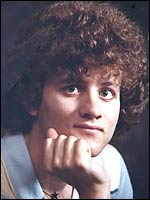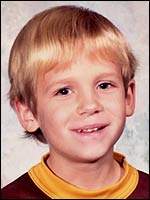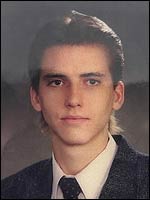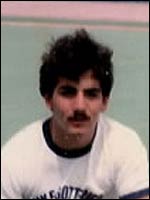Through Kansas parishes,
a trail of suicide By Thomas Farragher [See also our detailed assignment history of Rev. Robert Larson with links. In particular, see Hope, by Janet Patterson.] It was, they believed, an honor.
There were five of them, hand-picked by the Rev. Robert K. Larson, a charismatic and demanding priest, known for stem-winding sermons and icy glares he would shoot toward parishioners whose babies' cries pierced his Sunday service, or who dared to creep into church even moments after he'd begun to deliver the word of the Lord. Now, as their families explore the genesis of haunting downward spirals - desperate paths to isolation, hopelessness and self-destruction - they trace the suicides of their five sons to Larson, a now-imprisoned former priest who dressed dashingly, drove fancy cars, and molested his altar boys before striding imperiously down the aisle of churches where he was revered. Eric Patterson, Gilbert Rodriguez, Paul Tafolla, Bobby Thompson, and Daniel Romey lie in rural graveyards today. And their survivors, law enforcement officials, and some of the psychiatrists who tried to help say Larson's alleged sexual attacks - and church officials who they say must have known about them - bear some responsibility for their deaths. ''These boys' blood is on their hands, whether they believe it or not,'' said Rachel Rodriguez, Gilbert's mother and Paul's aunt. ''We weren't allowed to protect our children,'' said Janet Patterson, whose 29-year-old son, Eric, shot himself to death in October 1999. Some of the men's childhoods were idyllic. Some came from homes without fathers. Later in life, some would be tormented by alcohol or drugs. Some earned college degrees and pursued lives as priests themselves. All of them ended their lives by gunshots, drugs, or in an invisible cloud of odorless gas. Four of the suicides have occurred since 1996. In the kaleidoscope of experiences and associations that shape each life, tracing suicide to a pattern of sexual abuse that occurred years before is an exercise in imprecision. Larson's lawyer, Daniel Monnat, says there is no proven link between his client and the deaths of his former altar boys. ''I don't mean to be unsympathetic to their perception of things,'' Monnat said. ''But I've never heard any substantiation of it.'' But for the families of five dead men who once knelt in prayer at Larson's altar, and for those who investigated his crimes, the connection is the clear common denominator. Their sons and brothers began to turn introspective, sad, short-tempered, and - ultimately - dangerously desperate, they say, after Larson's assaults. ''The link is the sexual molestation,'' said Townsend Walton, a police detective in the Wichita suburb of Newton, who investigated separate instances of child abuse for which Larson, 72, is serving a three- to 10-year sentence. ''Unfortunately, these five couldn't handle it as well as the other ones and ended up committing suicide. I can readily see the connection.'' Barbara Blaine, the founder and president of the support group Survivors Network of those Abused by Priests, said there is anecdotal evidence but no scientific data linking clergy sexual abuse to suicide. She had no estimate for a total number of suicide deaths. ''We have not done any studies like that, but there's obviously a link to have so many [in Kansas]. Suicide is an act of supreme depression. So there is a link,'' she said. One single mother saw Larson as a godsend As the families look back on it now, some are guilt-ridden or feel bitterly foolish about how their embrace of Larson cleared the chilling path between him and their boys. They welcomed Larson and encouraged their sons in a way that would be familiar to many victims of another pedophile priest, John J. Geoghan. Now defrocked, Geoghan is the convicted child molester whose repeated abuse of children, and the church's inaction to curb it, helped trigger the clergy abuse scandal that has shaken the Boston Archdiocese and the American Catholic Church. But unlike in Massachusetts, Catholics are a distinct minority here, and families of the suicide victims have not filed civil suits against the church. When Linda E. Munson was newly divorced and working overtime to raise her four children in the early 1980s, she regarded Larson - who would stop by with bags of groceries and escort her son Bobby to a nearby amusement park - as a godsend. ''Larson took Bobby under his wing and I thought: Isn't this wonderful? Bobby was prime for it. He was lonely and I was a single mother,'' Munson said. ''Larson was kind. He was well spoken. I thought he was a wonderful man. He was good at what he did. And he was good at getting to his victims.'' By some accounts, Larson's assaults began in the 1960s when he served as a church pastor in Wichita. Karen Schneweis recalls complaints about the priest in the mid-1970s when she worked for the local Catholic social services organization and Larson was managing a resettlement program that found homes for thousands of Vietnamese refugees. At lunch, Schneweis recalled Larson's hand running up and down the legs of Vietnamese boys clearly uncomfortable with the contact. When she complained to her supervisor, she said he replied: ''Oh God, here we go again,'' and promised to take her report to the bishop. In early 1981, when Joan Relph's husband told her that he had been abused by Larson, she immediately contacted the pastor of her local church and officials at the chancery in Wichita. ''We're well aware of the situation, and we're taking care of it,'' Relph recalled her pastor telling her. But as complaints against Larson mounted, the church's response was to get Larson into treatment for alcohol abuse and psychiatric problems, and then reassign him as pastor here and in Newton, where he enjoyed easy access to little boys whose shirts he found chronically untucked. Numerous victims, in interviews and court records, said Larson fondled them in the church's sacristy under the guise of improving their sartorial appearance. ''They moved him from church to church,'' said Walton, the police detective. ''The bishop I talked to told me they enrolled Larson into a mental health place so he could be evaluated, and he was not diagnosed as a pedophile. But he was taking an altar boy in the car with him during those evaluations and on the way back, he would be feeling the guy up in the car. So, give me a break.'' Monsignor Robert Hemberger, chancellor of the diocese of Wichita, at first agreed to an interview with the Globe last week. At the chancery in downtown Wichita, Hemberger then requested to talk only off the record about Larson. When asked whether the church in Wichita has pledged itself to the policy of openness and transparency adopted by all US Catholic bishops in Dallas last month, Hemberger smiled thinly, expressed broad sympathies for the families, and then politely declined all other comment. One victim shot himself in the head In November 1978, Daniel Romey shot himself in the head with a handgun. He died three months after his 23d birthday. His sister, RoxAnne, found his body in a darkened basement stairway, slumped against a door at his home in Topeka. ''To this day, I have problems opening doors when it's dark inside,'' she said. She said her brother was diagnosed as a paranoid schizophrenic shortly after he turned 18 but had stabilized himself enough to work as a nursing home orderly. Romey told family members that Larson would abuse him at private pool parties and during Catholic Youth Organization outings when he was 13 years old, his sister said. ''It just rocked his world,'' said Romey. Bobby Thompson never told anyone precisely what happened during the daylong trips he took with the priest, who doted on him at St. Joseph Church and gave him his first communion. When he was just 8, Larson chose him for altar service usually reserved for boys a few years older. His brother recalls the priest taking the young boy from his parochial school classroom, telling his teachers that he needed the boy to help to clean the rectory. ''I was told that Larson took him to Joyland in Wichita,'' said Munson, Bobby's mother, who now lives in Colorado. ''That was my understanding of where they went. But I don't know where he took him. I feel like a fool now. It was blind trust.'' When Thompson turned 11, he began acting out. He would toss eggs at cars or shoot out windshields with a BB gun. He developed several tics, including the constant licking of his lips that grew red and chapped. He confided to a friend that he had been sexually abused, his mother said. In a 1990 psychological evaluation performed in Colorado, a clinical psychologist concluded that ''previous suspicions of sexual abuse by a priest in Bobby's early school years seems highly likely based on his concerns about masculinity, his attempts to avoid closeness particularly with his stepfather... his avoidance of his sexuality, and his confused identity and depression.'' His mother wrote a letter to Wichita Bishop Eugene Gerber, asking about rumors of Larson's abuse, wondering whether it could help explain her son's steep psychological slide. The church's reply, received two years after the diocese had removed Larson for sexual molestation and sent him to a Maryland treatment center, was curt, unresponsive, and silent about Larson's abusive conduct, she said. By the fall of 1996, 21-year-old Bobby Thompson was working for the local library district, shelving books. On the afternoon of Oct. 4, he walked into his mother's closed garage, started his car's engine, and sat down to die. ''It has just become too much pain and trouble for me to continue on,'' he wrote in a note. ''Thank you for always trying to help me out. The fault for this is not yours. You did everything you could. I don't want any regret for anyone as this should leave with me. I have seen over and over again that my life will never be how I want it to be. So I have to take the easy way out. Goodbye and love always. Your child, Bobby J. Thompson.'' Over the next four years, three more of Larson's former altar boys would end their lives. Two of them, Gilbert Rodriguez and Paul Tafolla, were first cousins who grew up together in Newton, a railroad town where they were raised by Gilbert's parents. Just a year apart in age, the boys bonded like brothers. Gilbert, a quiet kid, was the family peacemaker. Paul was more social, becoming the first Mexican boy to be named homecoming king at Newton High School. Gilbert earned a bachelor's degree in political science at Wichita State University and graduated from Conception Seminary College in Missouri, where, his mother said, his enthusiasm for life as a priest withered. Paul was a graduate of Emporia State University, where he received a degree in rehabilitative services. He married twice. When they were children, Gilbert once told his brother Robert, himself a victim of Larson's abuse, that Larson forced Gilbert and Paul to perform oral sex on him. ''Their unhappiness started right at that time,'' Rachel Rodriguez said. ''It was just like having a puzzle and having a missing piece. But now I see. The puzzle fits.'' Gilbert Rodriguez walked to a stand of trees on the edge of a grain field in his hometown on Sept. 9, 1998, and shot himself to death with a shotgun. Seventeen months later, Paul Tafolla died of a drug overdose in a Topeka hotel room. Both men, former altar boys at St. Mary's Church in Newton, were 31 years old. In court, he wore a bullet-proof vest When Wichita prosecutors learned of the five suicides linked to Larson they briefly considered holding Bishop Gerber criminally responsible for failing to protect the boys, Detective Walton said. But because of legal restrictions, Larson could be charged only with crimes he committed in Harvey County, north of the city. In March 2001, when he appeared in the courthouse across the street from his old church to plead guilty to four sex crimes against four other altar boys, Larson had been stripped of his Roman collar. He wore a bullet-proof vest. By then, he had been diagnosed with the sexual disorder known as ephebophilia, a sexual attraction to adolescent children. ''You did nothing wrong,'' Larson told his victims. ''You in no way encouraged me in my behavior. It was I who imposed myself on you, on your personal privacy, and I'm sorry for that. If there was some way I could erase all that, I would do it in a minute. But I can't do that.'' Those words hold no consolation for Janet and Horace Patterson, whose son Eric was an altar boy at Larson's jubilee Mass in 1983, marking the 25th anniversary of his ordination. They measure the deterioration of their son's psyche by the abuse he said he had suffered at the hands of the priest who used to live in the small, brick rectory next to St. Joseph Church. A tall boy who played basketball and ran track, attended Kansas State University, and studied Spanish in Mexico, Eric began to struggle with a depression that gradually left him with a stony, sad visage. He hoped to join the priesthood as a member of a religious order in Connecticut but was ultimately rejected. He took up sky diving. He joined a rock band. His weight began to fall precipitously. ''He said, `Mom, I can't eat. I just can't seem to get a grip on things. Nothing seemed right,''' Janet Patterson recalled. During one of Eric's hospitalizations, his sister, Becky, told him she disagreed with his vision of God as a vindictive, supreme being ''that's out to get you.'' ''We think of God as loving and merciful,'' Becky told Eric, according to their mother. ''Have you always thought of God that way? And he said, `No. Not until I was 12. When I was 12, Father Larson practically raped me.''' About that time, a nurse found Eric beating his head against the tile floor in his room. ''That priest made him very, very sick,'' said Naoma Crisp-Lindgren, Eric's psychiatrist to whom he described his sexual abuse. David Finkelhor, professor of sociology and director of the Crimes Against Children Research Center at the University of New Hampshire, said those who are sexually abused are two to eight times more likely to commit suicide than the general population. ''The main reason we see that link is the sense of stigma and shame that surround what happened and a kind of social isolation that may result,'' said Finkelhor. By 1997, the Pattersons believed their son may have turned a corner. He was working for Circuit City selling computers and had become engaged to be married the following year. But, again, his weight began to plummet. The engagement was broken off. In the fall of 1999, Eric Patterson drove here to his boyhood home to visit his family for the last time. His mother wasn't there, but he told his father that he loved him, began to drive away, and then stopped and backed up. For five minutes he knelt quietly, petting the family dog, Buddy, before getting back into his car and traveling the 35 miles to his apartment in Wichita. He was found dead there on Oct. 29, 1999, shot in the head with a Colt .45 that his roommate had tucked under a bed. Thomas Farragher can be reached at farragher@globe.com. This story ran on page A1 of the Boston Globe on 7/18/2002. |
Any original material on these pages is copyright © BishopAccountability.org 2004. Reproduce freely with attribution.




